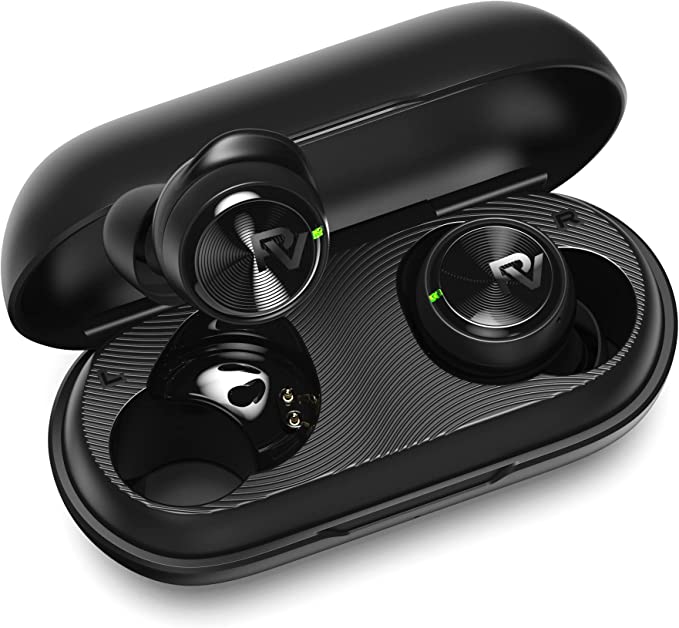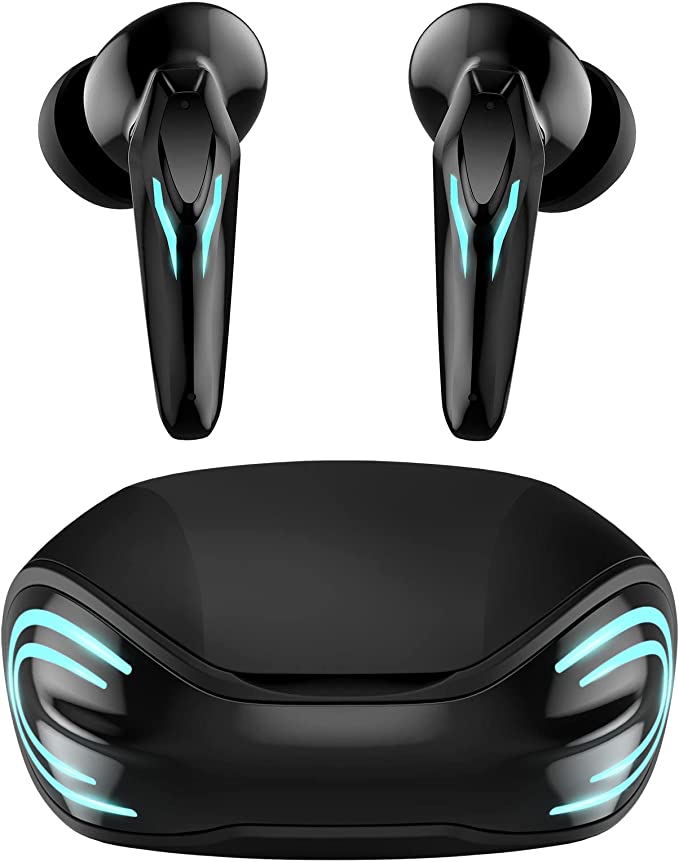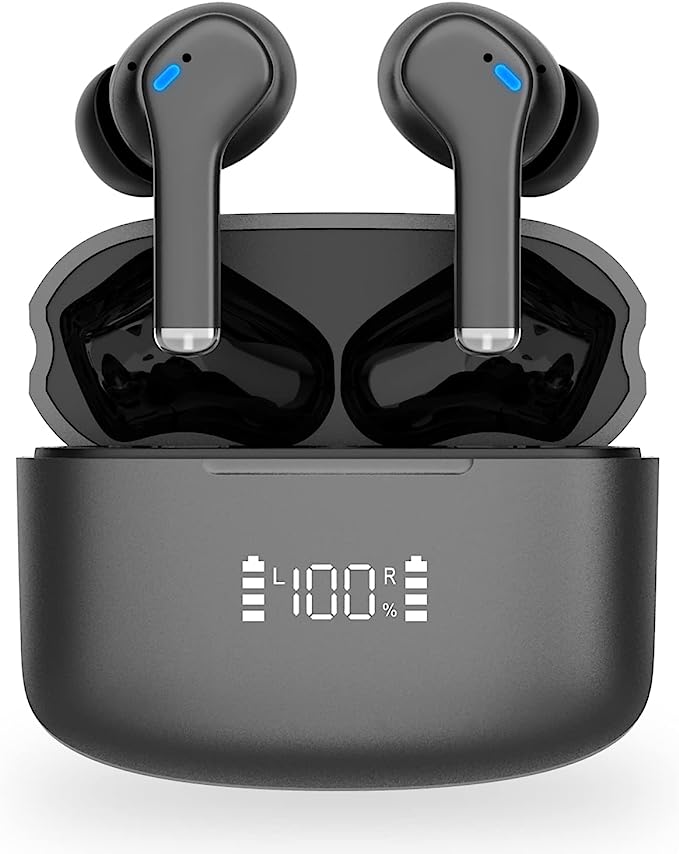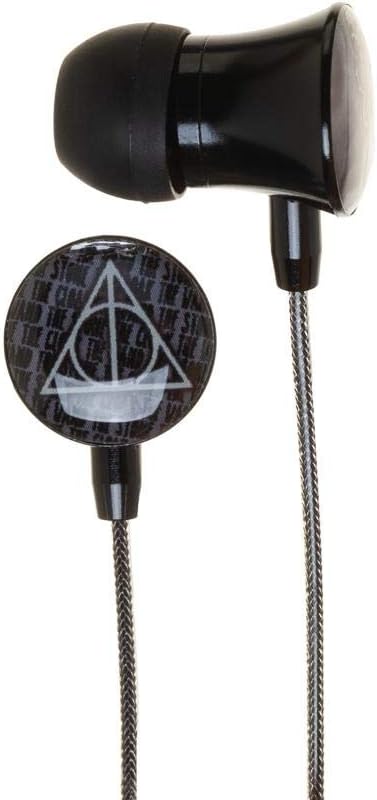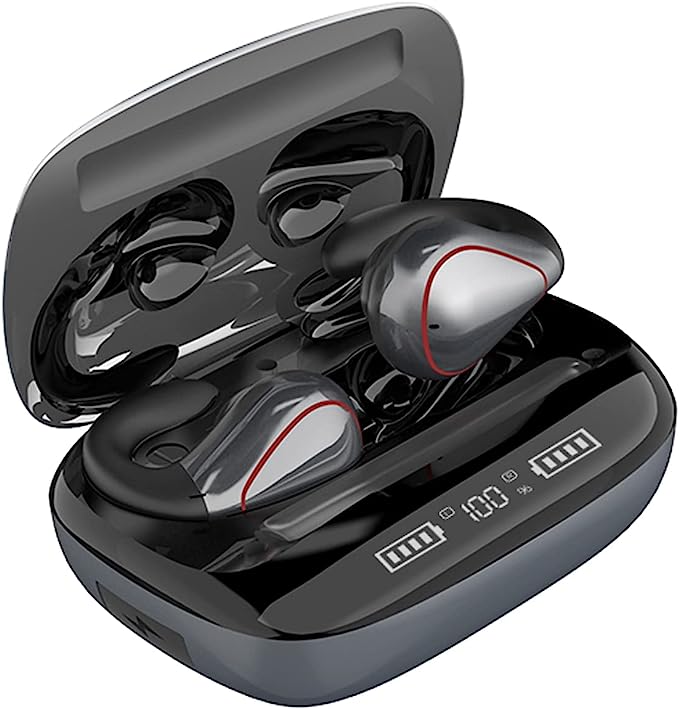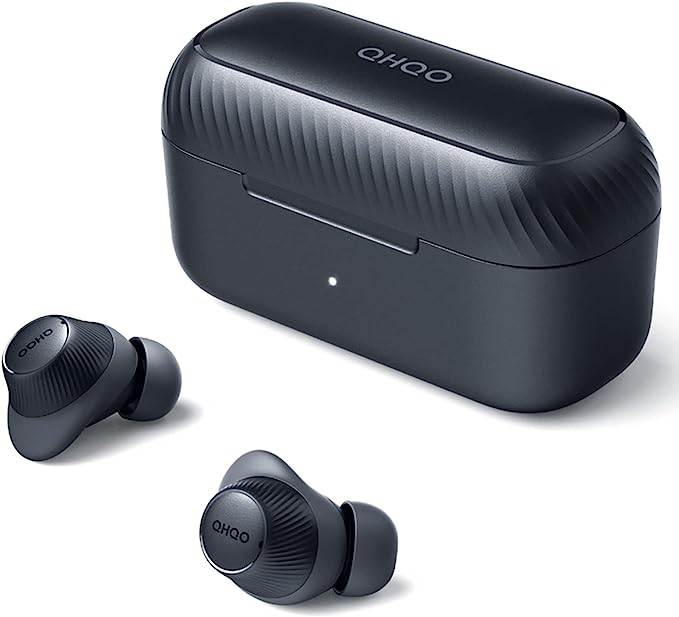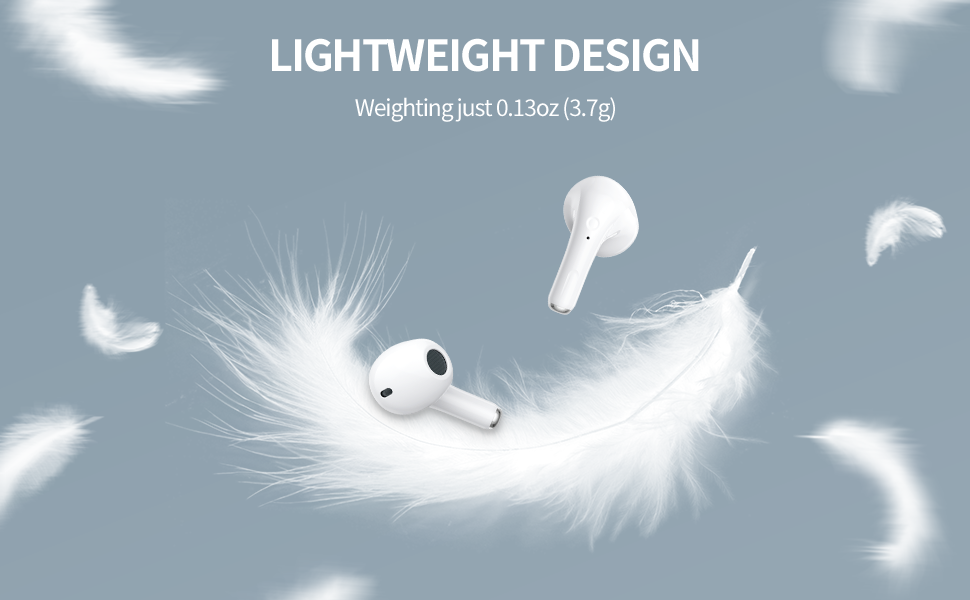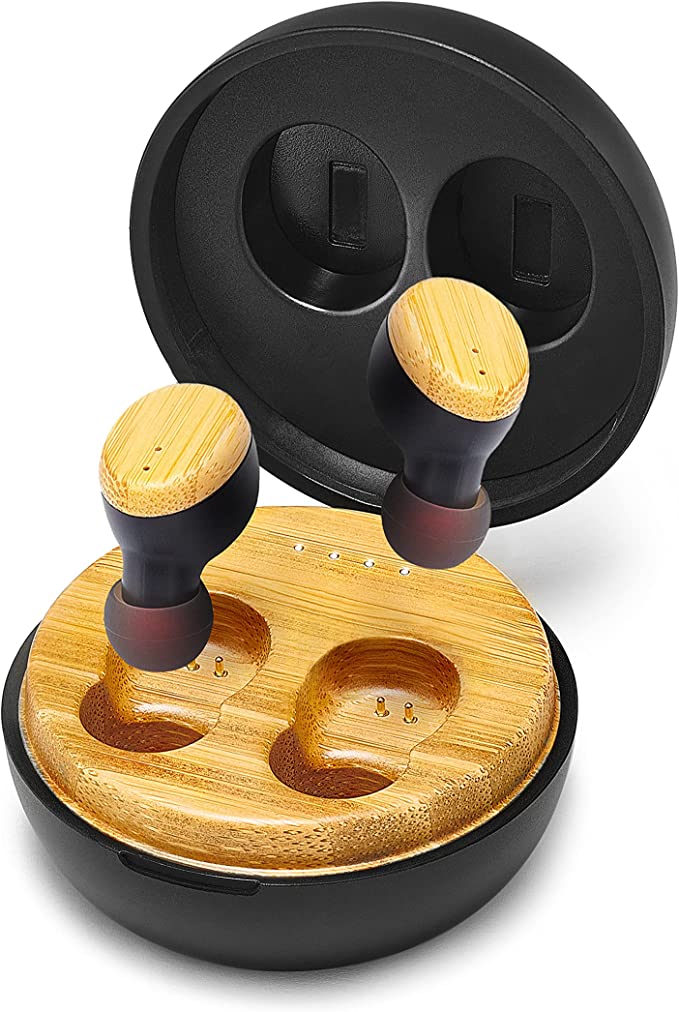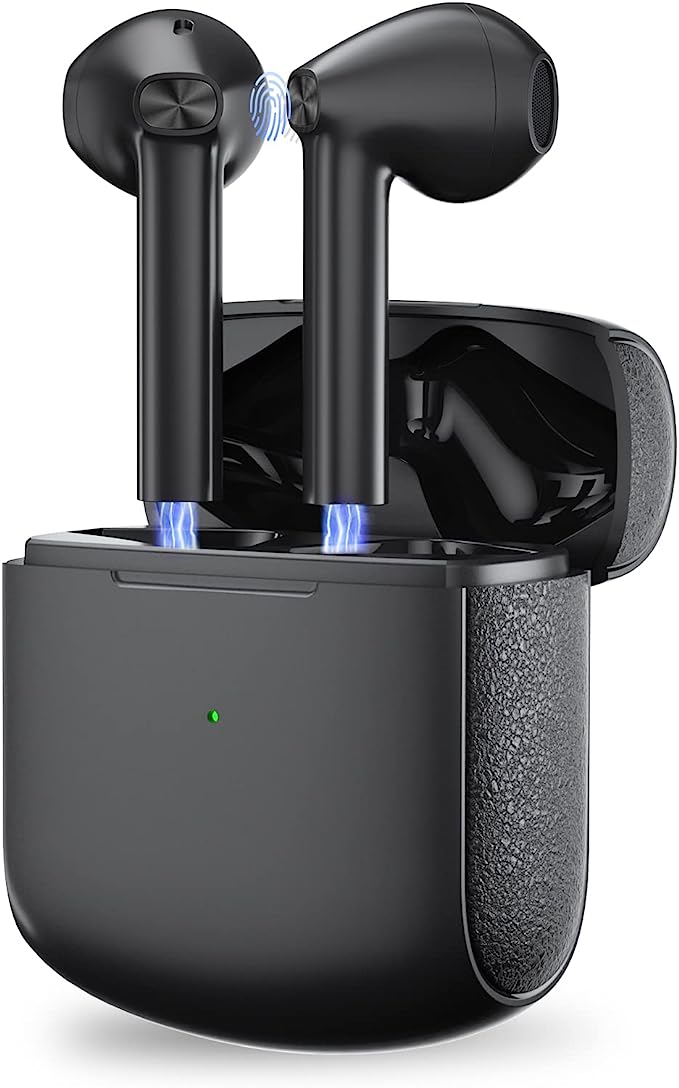KENKUO TG911 True Wireless Earbuds: Big Bass, Long Playtime, and Comfort
Update on March 20, 2025, 3:39 p.m.
Imagine this: you’re at the gym, ready to crush your workout. You reach for your earbuds, and… a tangled mess of wires. Sound familiar? For years, this was the daily struggle for anyone who wanted to enjoy music on the go. The frustration of untangling cords, the constant snagging on clothing or equipment – it was enough to make you want to ditch the music altogether. But thankfully, those days are largely behind us, thanks to the rise of wireless audio.

The Evolution of Freedom: A Brief History of Wireless Audio
The quest for wireless listening experiences isn’t new. Early experiments with radio headphones date back to the mid-20th century, but these were bulky, expensive, and suffered from poor sound quality and interference. The real breakthrough came with the development of Bluetooth technology in the late 1990s. Bluetooth, named after a 10th-century Danish king, provided a standardized way for devices to communicate wirelessly over short distances using radio waves. The first Bluetooth headsets appeared in the early 2000s, primarily for phone calls. Over time, Bluetooth technology evolved, becoming more power-efficient, reliable, and capable of transmitting higher-quality audio. This paved the way for the true wireless earbuds we know and love today – compact,

Introducing the KENKUO TG911: Affordable Wireless Sound
The KENKUO TG911 earbuds represent an accessible entry point into the world of true wireless audio. These earbuds are designed to be lightweight, comfortable, and easy to use, offering a blend of essential features at a budget-friendly price. The in-ear design, coupled with a selection of ear tip sizes, aims to provide a secure and comfortable fit for a wide range of users. The earbuds boast Bluetooth 5.2 connectivity, promising a stable connection and extended battery life. Let’s delve into the technology that makes these earbuds tick.
Bluetooth 5.2: The Unsung Hero of Connectivity
Bluetooth 5.2 is the engine that drives the wireless experience of the TG911. But what makes it better than previous versions? Several key improvements contribute to a superior user experience:
- Enhanced Connection Stability: Bluetooth 5.2 incorporates features that make the connection between the earbuds and your device more robust, reducing the likelihood of dropouts or interruptions, even in environments with a lot of wireless interference (like a busy coffee shop or airport). This is achieved through improvements in the connection negotiation process and better handling of signal conflicts.
- Lower Latency: Latency refers to the delay between when a sound is produced by your device and when you hear it in your earbuds. Bluetooth 5.2 reduces this latency, making it better for watching videos or playing games, where audio-visual synchronization is crucial. While not as low-latency as specialized gaming codecs, it’s a noticeable improvement over older Bluetooth versions.
- Improved Power Efficiency: Bluetooth 5.2 is designed to consume less power, extending the battery life of both the earbuds and the connected device. This is achieved through more efficient data transmission and connection management. Think of it like a more fuel-efficient car – it can travel further on the same amount of gas.
- LE Audio (Future-Proofing): While not fully implemented in most devices yet, Bluetooth 5.2 lays the groundwork for LE Audio, a new standard that promises even better audio quality, lower power consumption, and new features like Auracast broadcast audio (allowing multiple users to connect to the same audio source).
In essence, Bluetooth 5.2 provides a more seamless and reliable wireless experience, forming the foundation for the TG911’s functionality.

Decoding the Sound: Audio Codecs Explained
While Bluetooth provides the wireless connection, audio codecs are responsible for how your music is encoded and decoded for transmission. Think of them as translators, converting the digital audio files on your phone or computer into a format that can be sent wirelessly to your earbuds, and then back into sound you can hear. Different codecs use different compression algorithms, and this affects the sound quality.
The KENKUO TG911, like most Bluetooth earbuds, almost certainly supports the mandatory SBC (Subband Coding) codec. SBC is a universal standard, ensuring compatibility with virtually any Bluetooth device. However, SBC is known for its relatively high compression, which can result in some loss of audio detail, especially at lower bitrates.
It’s possible that the TG911 also supports AAC (Advanced Audio Coding). AAC is a more advanced codec commonly used by Apple devices (iPhones, iPads, Macs). It generally offers better sound quality than SBC at similar bitrates, providing a more detailed and nuanced listening experience. However, the product information doesn’t explicitly state AAC support, so this remains an assumption.
Higher-end earbuds often support codecs like aptX or LDAC, which offer even lower compression and higher bitrates, resulting in near-lossless audio quality. However, these codecs are typically found in more expensive models and require both the transmitting device (e.g., your phone) and the receiving device (the earbuds) to support them. The absence of these codecs in the TG911 is a reflection of its budget-friendly positioning.
Inside the Earbud: Dynamic Drivers and Sound Production
The sound you hear from the KENKUO TG911 is produced by 8mm dynamic drivers. Dynamic drivers are the most common type of driver found in headphones and earbuds. They work on the same basic principle as a loudspeaker, just on a much smaller scale.
Here’s a simplified explanation:
- Electrical Signal: An electrical audio signal from your device (via Bluetooth and the codec) is sent to the driver.
- Voice Coil: This signal flows through a small coil of wire (the voice coil) attached to a diaphragm.
- Magnetic Field: The voice coil is positioned within a magnetic field created by a permanent magnet.
- Diaphragm Movement: When the electrical signal passes through the voice coil, it creates a varying magnetic field. This interacts with the permanent magnet’s field, causing the voice coil (and the attached diaphragm) to move back and forth.
- Sound Waves: The movement of the diaphragm vibrates the air, creating sound waves that travel to your ear.
The size, material, and construction of the diaphragm, voice coil, and magnet all influence the sound characteristics of the driver. While 8mm is a relatively common driver size for earbuds, it’s important to remember that size alone doesn’t determine sound quality. The tuning and overall design of the driver play a crucial role.

The Quiet Zone: Understanding Passive Noise Isolation
The KENKUO TG911 relies on passive noise isolation to reduce external noise. Unlike active noise cancellation (ANC), which uses microphones and electronic circuitry to generate anti-noise waves, passive isolation works by physically blocking sound waves from entering your ear canal.
The primary mechanism for passive noise isolation is the seal created between the ear tip and your ear canal. A good seal prevents sound waves from leaking in, effectively reducing the level of ambient noise you hear. This is why choosing the right size ear tips is so crucial – a poor seal will significantly reduce the effectiveness of passive isolation.
Passive noise isolation is generally more effective at blocking higher-frequency sounds (like the hissing of an air conditioner or the clatter of keyboards) than lower-frequency sounds (like the rumble of a bus engine). While it can’t completely eliminate external noise like ANC can, it can still significantly improve your listening experience, especially in moderately noisy environments. The tight seal, blocking sounds, may cause a pressure on the eardrum, which can be solved by slightly moving the earbuds.
Finding Your Fit: The Importance of Eartips
As mentioned above, the ear tips play a critical role in both comfort and sound quality. The KENKUO TG911 includes three sizes of ear tips (small, medium, and large) to accommodate different ear canal shapes and sizes.
Human ear canals vary considerably in shape and size. An ear tip that fits one person perfectly might be too large or too small for another. A properly fitting ear tip should:
- Create a snug but comfortable seal: You should feel a gentle pressure, but not pain or discomfort.
- Remain securely in place: The earbud shouldn’t feel loose or like it’s going to fall out, even during movement.
- Maximize sound isolation: A good seal will block out the most external noise.
- Optimize sound quality: A proper seal ensures that the bass frequencies are reproduced accurately and that the sound isn’t “leaky” or thin.
Experimenting with the different ear tip sizes is essential to find the best fit for your ears. You might even find that you need different sizes for each ear!
Powering Your Day: Battery Life and the Charging Case
The KENKUO TG911 earbuds offer up to 8 hours of continuous playback on a single charge. This is a respectable figure for true wireless earbuds, especially in this price range. The included charging case provides an additional 35 hours of battery life, bringing the total listening time to 43 hours.
The charging case acts as both a protective case and a portable power bank for the earbuds. It contains its own battery, which is recharged via a USB-C cable. When you place the earbuds inside the case, they automatically begin charging. The case typically uses magnetic contacts to ensure proper alignment and charging.
The earbuds and the charging case likely use lithium-ion batteries, the standard for most portable electronic devices. Lithium-ion batteries are popular because they offer a good balance of energy density (how much energy they can store for their size), lifespan, and safety.
Built to Last (and Resist Sweat): IPX5 Water Resistance
The IPX5 water resistance rating of the KENKUO TG911 means that the earbuds are protected against low-pressure water jets from any direction. This makes them suitable for workouts, where you might sweat, or for use in light rain. However, it’s important to note that IPX5 does not mean the earbuds are fully waterproof. They shouldn’t be submerged in water or exposed to high-pressure water (like a shower).
The “IP” in IPX5 stands for “Ingress Protection,” and the rating system is defined by international standards. The “X” indicates that the device hasn’t been tested for dust protection, while the “5” refers to the level of water protection.
Touch and Go: Intuitive Controls
The TG911 earbuds feature touch controls, allowing you to manage music playback, answer calls, and activate your voice assistant (like Siri or Google Assistant) with a simple tap or series of taps on the earbuds themselves. This eliminates the need to fumble for your phone every time you want to adjust the volume or skip a track.
Touch controls typically use capacitive sensors, similar to those found in smartphone touchscreens. These sensors detect the change in capacitance caused by your finger touching the surface of the earbud. The earbud’s internal circuitry then interprets these touch gestures and executes the corresponding command.
Sound in Context: Real-World Use Cases
Let’s consider how the KENKUO TG911 might perform in different everyday scenarios:
- Commuting: On a bus or train, the passive noise isolation will help to reduce the rumble of the engine and the chatter of fellow passengers, allowing you to enjoy your music or podcasts more clearly. The wireless design eliminates the hassle of tangled wires.
- Working Out: The IPX5 water resistance protects the earbuds from sweat, and the secure fit (with the right ear tips) ensures they stay in place during exercise.
- Working or Studying: The wireless freedom allows you to move around your workspace without being tethered to your computer. The long battery life means you can listen for extended periods without needing to recharge.
- Making Calls: The built-in microphone allows you to take calls hands-free. However, the lack of advanced noise cancellation for the microphone might mean that call quality could be affected in noisy environments.
Listen Responsibly: A Word on Hearing Health
It’s important to be mindful of your hearing health when using any type of headphones or earbuds. Listening to music at high volumes for extended periods can cause permanent hearing damage.
Experts recommend following the 60/60 rule: listen at no more than 60% of the maximum volume for no more than 60 minutes at a time. It’s also a good idea to take regular breaks from listening to give your ears a rest. If you experience any ringing in your ears (tinnitus) or muffled hearing after using headphones, it’s a sign that you may be listening at too high a volume.
The Broader Picture: Wireless Earbuds in Context
The KENKUO TG911 exists in a very busy market. There are countless other models of true wireless earbuds that cover all budgets. At the entry level price point, the focus is often on value. Compromises are made (like using only basic codecs, or passive noise isolation), while features like 5.2 connectivity and good battery life are maintained.
Conclusion: The Value Proposition of the KENKUO TG911
The KENKUO TG911 true wireless earbuds offer a compelling combination of affordability, convenience, and essential features. While they don’t boast high-end features like active noise cancellation or support for advanced audio codecs, they deliver a solid listening experience for everyday use. The Bluetooth 5.2 connectivity, long battery life, comfortable fit, and IPX5 water resistance make them a practical choice for budget-conscious consumers who want to enjoy the freedom of wireless audio without breaking the bank. They represent a good value for those prioritizing practicality and affordability over premium features. They are a good option for users looking for a simple, reliable, and affordable way to enjoy music and calls on the go.



